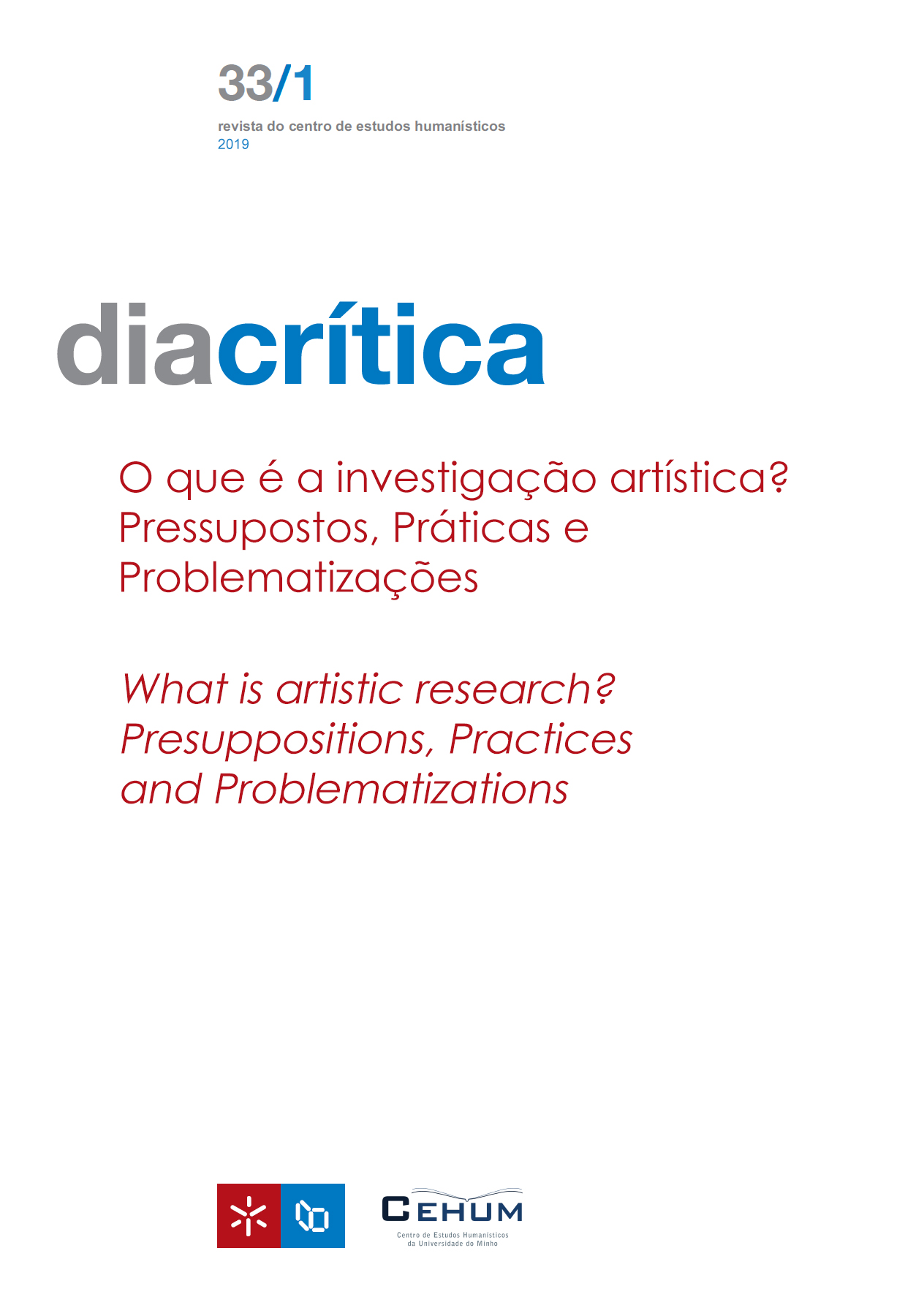The Fool, the Sage, the Bard (into the machine): self-referential processes of artistic research in cyberliterature
DOI:
https://doi.org/10.21814/diacritica.5037Keywords:
Cybernetics, Cyberculture, Cyberliterature, Creative research, Theory of Play, CreativityAbstract
Recovering part of the Koestlerian theory of creativity that understands the creative act as a ‘bisociation’ of two or more structures of thought, this paper proposes a reflection on the concept of ‘artistic research’ in the light of its self-referential processes in Cyberliterature. Five decades after the publication of The Act of Creation (1964), the confluence between the playful, scientific and artistic aspects Arthur Koestler identifies in the human creative act are now understood as outdated. Namely, if taking into account the digital age and its influence on virtually every sphere of knowledge. However, succisa virescit, it is in the re-reading of its inaugural intention –the criticism of a given academic tendency in reducing the human being to the status of a conditioned automaton –that, paradoxically, it is possible to introduce a new variable in Koestler’s famous tripartite formula: the machine. Moreover, regarding the tension that may exist between programmability and creation, and from a pluri-inter-transdisciplinary approach, it is also our intention to illustrate the ways in which barriers between creation and research become blurred, hence paving the way for the potential realization of a renewed scientific paradigm.
References
Aarseth, E.(1997).Cybertext. Perspectives on Ergodic Literature. The Johns Hopkins University Press. DOI: https://doi.org/10.56021/9780801855788
Baldwin, S. & Torres, R. (2017). e-lit jazz. Hyperrhiz: New Media Cultures, Spring 2017, <http://hyperrhiz.io/hyperrhiz17/gallery/1-baldwin-torres-jazz.html>. Consultado em: 31 jan. 2019. DOI: https://doi.org/10.20415/hyp/017.g01
Barbosa, P. (1977). A literatura cibernética 1: Autopoemas grados por computador.Porto: Ed. Árvore.
Barbosa, P. (1996). A ciberliteratura; criação literária e computador. Lisboa: Edições Cosmos.
Barbosa, P. (2006). Aspectos quânticos docibertexto.InCibertextualidades 1(pp. 11–42).Porto: Ed. UFP.
Barbosa, P. (2012). Contributos para uma Teoria Quântica do cibertexto. In Manuel Portela (Ed.),Revista de Estudos Literários. Literatura no século XXI, 2(pp. 121–184). Faculdade de Letrasda Universidade de Coimbra, ISSN 2182-1526. Disponível em <http://impactum-journals.uc.pt/rel/issue/view/121>, Consultado em: 30 jan. 019. DOI: https://doi.org/10.14195/2183-847X_2_4
Barbosa, P. &Torres, R.(2017). Materialidade e transdimensionalidade nas novas textualidades electrónicas: Uma transição de paradigma? Entrevista de Rui Torres (RT) a Pedro Barbosa (PB), março de 2016. InCibertextualidades8. Videojogos(pp. 141–162). Porto:Ed. UFP.
Barthes,R.(1990). O óbvio e o obtuso: Ensaios críticos III(p. 198). Rio de Janeiro: Nova Fronteira.
Biggs, I.(2006). Hybrid texts and academic authority: The wager in creative practice research. In K. Macleod & L. Holridge (Eds), Thinking through art: Reflections on art as research(pp. 190-200).London: Routledge.
Biggs, S.(2009). New media. The ‘First Word’. In Smith, H. & Dean, R. T. (Eds.),Practice-led research, research-led practice in the creative arts(pp. 66–83). Edimburgo: Edinburgh University Press. DOI: https://doi.org/10.1515/9780748636303-004
Caillois,R. (1990). Os jogos e os homens: Amáscara e a vertigem. J. G.Palha(Trad.). Lisboa: Edições Cotovia. [1958]
Cazeaux, C.(2006). Interrupting the artist: Theory, practice and topology in Sartre’s aesthetics. In K. Macleod &L. Holridge (Eds.), Thinking through art: Reflections on art as research(pp. 40-46). London: Routledge.
Elkins, J.(2006). Afterword: Beyond research and new knowledge. In K. Macleod &L. Holridge (Eds.), Thinking through art: Reflections on art as research(pp. 241–247). London: Routledge.
Frayling, C. (2006). Foreword.InK. Macleod & L. Holridge (Eds.), Thinking through art: Reflections on art asresearch. London: Routledge, XIII–XIV.
Huyssen, A. (2001). Foreword: The return of Diogenes as postmodern intellectual. In P. Sloterdijk (Trad.), Critique of Cynical Reason(pp. ix–xxv). Michael Eldred. Minneapolis and London: University of Minnesota Press.
Koestler, A. (1997). The act of creation. London: Picador.
Kubrick, S. (1968). 2001: A Space Odyssey. Stanley Kubrick Productions. Metro-Goldwyn-Mayer. 02h29m.
MacLeod, K. &Holdridge, L. (2006). Introduction.Inid(Eds.), Thinking through art:Reflections on art as research(pp. 1–14). London: Routledge.
Portela, M. & Marquesda S., A.(2018a). A strange metapaper on computing natural language. Electronic Book Review. (Feb. 2018). Disponível em <http://electronicbookreview.com/ essay/a-strange-metapaper-on-computing-natural-language/>.Consultado em:14fev. 2019.
Portela, M. & Marques da S., A. (2018b). If then or else: Who for whom about what in which. A strange metapaper on computing natural language. Electronic Book Review(Feb. 2018). Disponível em:<http://electronicbookreview.com/essay/a-strange-metapaper-on-computing-natural-language/>.Consultado em:14fev. 2019.
Memmott, Talan (2006). Beyond Taxonomy: Digital Poetics and the Problem of Reading. In Morris, A. & Swiss, T(Eds.). New media poetics: Contexts, technotexts, and theories(pp. 293-396).Cambridge, London: The MIT Press, 2006. DOI: https://doi.org/10.7551/mitpress/5002.003.0020
Mourão, J. A. (1999). O discurso alquímico: Um imanentismo transcendente?In J. A.Mourãoet al. (Eds),Actas do I Colóquio Discursos e Práticas Alquímicas.Lisboa: Hugin Ed. Disponível em: <http://triplov.com/alquimias/alqjose.htm>. Consultado em: 28 jan. 2019.
Mourão, J. A.(2000). Alquimia online. Actas do Colóquio Internacional II Discursos e Práticas Alquímicas.Lisboa: Hugin Ed. Disponível em:<http://triplov.com/alquimias/jam1.htm>. Consultado em:28jan. 2019.
Poe, E. A. (2004). A Filosofia da Composição(1846).Poética(Textos Teóricos). H. Barras (Trad.). Gulbenkian: Lisboa.
Smith, H. &Dean, R.T. (2009). Introduction. In id. (Eds.) Practice-led research, research-led practice in the creative arts(pp. 1–7). Edimburgo: Edinburgh University Press. DOI: https://doi.org/10.1515/9780748636303
Sullivan, Graeme (2009). Making space: The purpose and place of practice-led research.In Smith, H. & Dean, R. T. (Eds),Practice-led research, research-led practice in the creative arts(pp. 45–46).Edimburgo: Edinburgh University Press. DOI: https://doi.org/10.1515/9780748636303-003
Torres, R.(2019). “”. Electronic Book Review(maio 2019). Disponível em: .Consultado em: 20 jul. 2019
Downloads
Published
How to Cite
Issue
Section
License
Copyright (c) 2023 Diogo Marques

This work is licensed under a Creative Commons Attribution-NonCommercial 4.0 International License.










